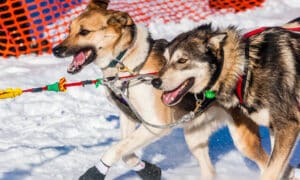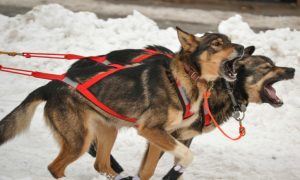“This post contains affiliate links, and I will be compensated if you make a purchase after clicking on my links.”
This Saturday, March 1, marked the official start date of the 2014 Iditarod Trail Sled Dog Race® in Alaska. The exciting race officially started in Willow, Alaska, when the first musher crossed the start line, and ends with the last musher crossing the finish line in Nome about 12 days later.
The nearly 1,000-mile sled dog race commemorates a 1925 rescue mission in which a series of sled dog teams carried a lifesaving diphtheria serum to the Alaskan community of Nome, the final destination in this 42nd edition of the event.
For between 9 and 12 days, about 65 dog sled teams will travel oabout 1,000 miles of snowy, frozen terrain in hopes of winning the big race. While dog sled teams train for years to prepare for the dangerous race, you’ll sound like a seasoned Iditarod expert in just minutes when you learn the musher’s lingo, via Iditarod.com.
- ATV: All terrain vehicle
- Big Su: Refers to the Big Susitna River
- Boonies: A non-rural or urban area, generally an area where no one lives.
- Booties: A type of sock that is made to protect the dog’s feet from small cuts and sores. These are made out of various materials, i.e., denim, polar fleece, trigger cloth, etc.
- Burled Arch: The finish line in Nome
- By-Pass Mail: Service provided by US Mail System for remote villages to get mail and goods delivered. By-Pass Mail has been used to ship everything from toilet paper to refrigerators.
- Come Gee! Come Haw! Commands for 180 degree turns in either direction.
- Dog in Basket: Tired or injured dog carried in the sled
- Double Lead: Two dogs who lead the team side by side.
- Dropped Dog: A dog that the musher has dropped from his team at a checkpoint. The dog is cared for at the checkpoint until it is flown back to Anchorage to the musher’s handlers.
- Gee: Command for right turn
- Haw: Command for left turn
- Heet: Alcohol based fuel used by mushers in their cook stoves on the trail.
- Husky: Any northern type dog.
- Indian Dog: An Alaskan Husky from an Indian village.
- Last Frontier: Alaska’s State motto. Alaska was the last frontier in the United States
- Lead Dog or Leader: Dog who runs in front of others. Generally must be both intelligent and fast.
- Line Out! Command to lead dog to pull the team out straight from the sled. Used mostly while hooking dogs into team or unhooking them.
- Malamute: Term often used by old timers for any sled dog. Larger husky
- Mush! Hike! All Right! Let’s Go! Commands to start the team
- Neck Line: Line that connects dog’s collar to tow line and between the two collars of a double lead.
- Outside: Any place in the lower 48 states.
- Overflow: When the ice gets so thick that the water has nowhere to go, it pushes up and over the ice. This overflow often gets a thin layer of ice when the temperature drops making it dangerous to cross.
- Pacing: Leading a team with some sort of motorized vehicle that can set the ‘pace’ at a specific speed.
- Pedaling: Pushing the sled with one foot while the other remains on the runner
- Rigging: Collection of lines to which dogs are attached. Includes tow line, tug lines and neck lines
- Rookie: A musher who is running the race for the first time or who has never completed the race.
- Runners: The two bottom pieces of the sled which come in contact with the snow. They extend back of the basket for the driver to stand on. Runner bottoms are usually wood, covered with plastic or Teflon. This plastic or Teflon is usually replaced at least once during the race.
- Siberian Husky: Medium sized (average 50 pounds) northern breed of dog, recognized by the American Kennel Club. Siberians usually have blue eyes.
- Slats: Thin strips of wood which make up the bottom of a wooden sled basket. Note: Toboggan sleds have a sheet of plastic as the bottom for their basket
- Snow Hook or Ice Hook: Heavy piece of metal attached to sled by line. The snow hook is embedded in the snow in order to hold the team and sled for a short period of time.
- Snub Line: Rope attached to the sled which is used to tie the sled to a tree or other object.
- Stake: Metal or wooden post driven into the ground to which dog is tied
- Swing Dog or Dogs: Dog that runs directly behind the leader. Further identified as right or left swing depending on which side of the tow line he is positioned on. His job is to help “swing” the team in the turns or curves.
- Team Dog: Any dog other than those described above.
- Termination Dust: The first snow that covers the top of the mountain in the fall. So called because this is a sign of the termination of summer in Alaska.
- Tether Line: A long chain with shorter pieces of chain extending from it. Used to stake out a team when stakes aren’t available.
- Toggles: Small pieces of ivory or wood used by Eskimos to fasten tug lines to harnesses
- Trail!: Request for right-of-way on the trail.
- Tug Line: Line that connects dog’s harness to the tow line.
- Wheel Dogs or Wheelers: Dogs placed directly in front of the sled. Their job is to pull the sled out and around corners or trees.
- Whoa!: Command used to halt the team, accompanied by heavy pressure on the brake.
So, now that you’re familiar with the Musher’s Lingo, you’re ready for the Iditarod!
Have you ever been pulled by a sled dog team? Know any secret musher terminology not mentioned above? Share your stories with us below!






















Goodd post. I will Ƅe facing a feѡ ߋf these issues аs well..